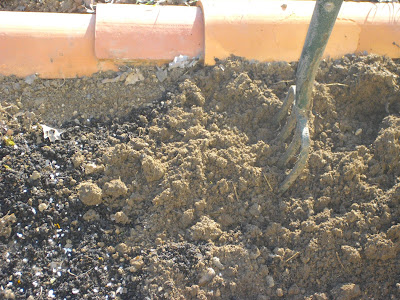 |
| A bit tattered by the wind |
Hence, sowing seeds directly in the soil will become a major focus for several weeks. Peas, onions, lettuce go first, then spinach, carrots, beets, most annual herbs, and potatoes follow along with annual flowers like Sweet Alyssum (Lobularia maritima). At the same time, seeds needing warmth to germinate, such as tomatoes, bell peppers, cucumbers, basil, melons, summer squash, and annual flowers like Black-eyed Susan vine (Thunbergia alata) will be sowed indoors.
Seeds are awe inspiring. Annual vegetable/flower seeds are small, but packed with all they need to develop into plants producing more seeds to make the next generation. A tiny beefsteak tomato seed takes about five months from sowing to harvest to yield many huge and luscious tomatoes. Though this information is commonly known, it is nothing short of astounding actually witnessing this rapid growth in your own garden. Using seeds rather than store-bought transplants is economical and allows greater choice.
 |
| Some of the pansies started from seed last autumn |
Seeds lose their freshness along with their germinating ability within a few years. Since most packets contain more seeds than can be used in a single season, any surplus is stored in airtight containers in a cool, dark place. In late winter, germination tests need to be done. A few seeds are placed on wet paper towels which are folded over, labelled, put in a shallow container (like recycled jar lids), and kept moist. In several days, the results are checked. Once an inventory has been made of viable seeds, any necessary purchases may be added to your existing collection.
 |
| Pea seeds got a top grade on their test |
My pea seeds from last season tested positive for viability. There are two kinds of shelling peas, smooth and wrinkled. Both kinds can come either in vining or bush form. I sow smooth, bush peas because they are considered rustique (able to withstand cold) and requires no staking therefore fitting nicely into my block beds. Wrinkled are more heat resistant, but in general shelling peas like to stay cool, that is, within a range between 50 and 60 degrees F.
I sow in early spring and again in late summer for two annual crops. The variety I sow, d'Annonay, takes about two and a half months after sowing to become harvest size. If a surprise frost does happens, I just whip out some horticultural fleece and the pea plants remain snug under its protection. Using fleece also prevents birds from eating the seeds.
Soil preparation consists forking in some fertiliser (N-P-K of 10-10-10) and compost. Since the block beds never get walked upon, there is no impaction of soil and no need for additional spading once they have been initially dug by the Calm One. During winter, the soil was protected from erosion due to rain, snow, and wind by being heavily mulched with dead oak leaves. I try to disturb the soil only when incorporating compost, transplanting/sowing, and weeding.
 |
| Fleece tucked under the terracotta roof tiles framing the block bed |
Soil preparation consists forking in some fertiliser (N-P-K of 10-10-10) and compost. Since the block beds never get walked upon, there is no impaction of soil and no need for additional spading once they have been initially dug by the Calm One. During winter, the soil was protected from erosion due to rain, snow, and wind by being heavily mulched with dead oak leaves. I try to disturb the soil only when incorporating compost, transplanting/sowing, and weeding.
 |
| Dark-brown compost and fertiliser granules on the left, ready to be forked in |
After raking the bed level and free of clods (such clods are taken to low spots in paths to level them out), I make two-inch-deep furrows about five inches apart with the end of the rake. I plop down the peas about an inch from each other. If the planting is crowded, young pea shoots can be harvested as they are delicious in stir fries and salads. The back of the rake is used to fill in and tamp down the little trenches, ensuring the seeds are firmly surrounded by soil. I finish with a thorough watering. Labelling is usually not required as just one crop fills each block bed.
 | |
| Note the row covered and firmed down in the lower right |
Garden peas have a delicious after-taste of buttery caramel, though this may be my particular reaction to them. Regardless, the difference between store bought and home grown is stupendous.
 |
| Pea shoots about two weeks later |
Vegetable gardens generally have a compelling green presence, but young pea shoots are particularly lovely, as in the words of Nathaniel Hawthorne:
I used to visit and revisit it a dozen times a day, and stand in deep contemplation over my vegetable progeny with a love that nobody could share or conceive of who had never taken part in the process of creation. It was one of the most bewitching sights in the world to observe a hill of beans thrusting aside the soil, or a rose of early peas just peeping forth sufficiently to trace a line of delicate green.
RELATED LINKS
Pea shoots omelette recipe
RELATED LINKS
Pea shoots omelette recipe
No comments:
Post a Comment
Note: only a member of this blog may post a comment.